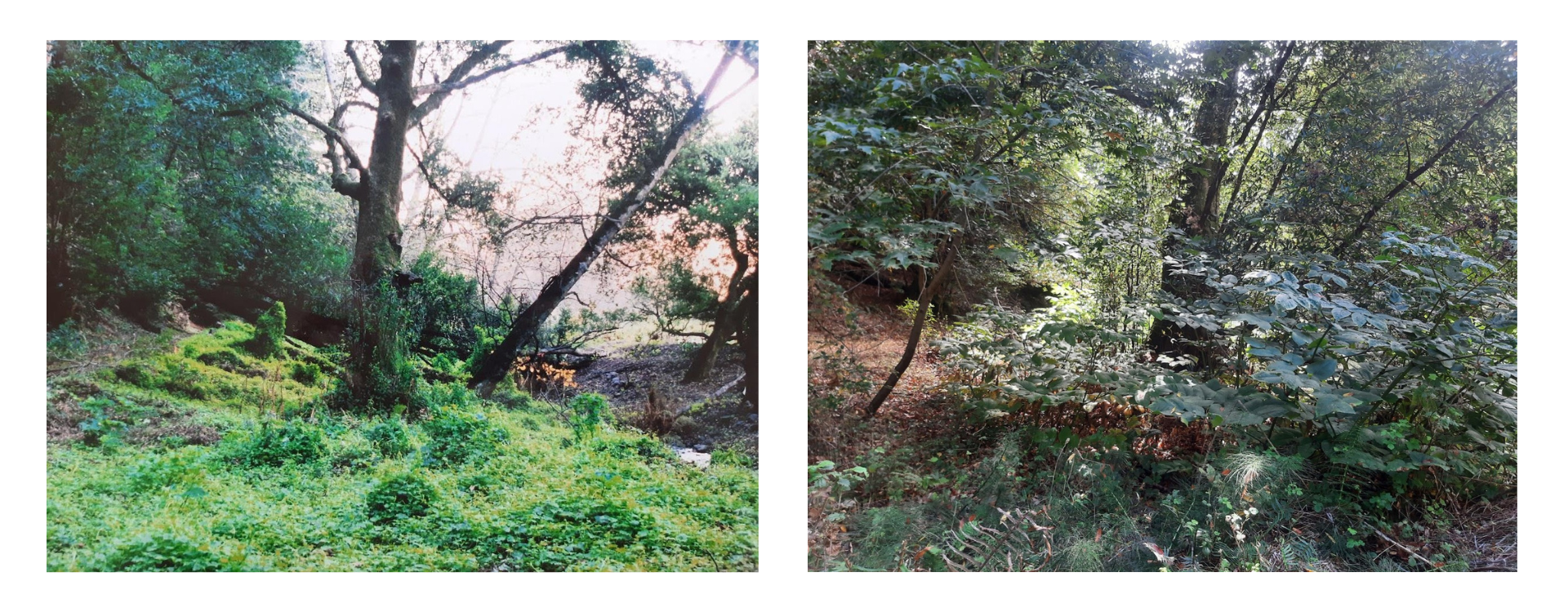Left: An area of Martin Griffin Preserve once overrun by Cape-ivy in 2002. Right: The same area at present day, now host to a mix of Elk Clovers, horsetails, native ferns, and blackberries.
Controlling Cape-ivy
Removing and burning plants may seem antithetical to land stewardship, but this is just what ACR’s land stewards and resource ecologists are up to this summer. The varied stewardship strategies employed across the preserves share the same goal: increasing the diversity of species for thriving ecosystems.

Volunteers continue to pull up the roots of Cape-ivy (Delairea odorata) along the creek in Volunteer Canyon at Martin Griffin Preserve – a project that has been ongoing for eight years. Cape-ivy was introduced in the 1960s as an ornamental plant and quickly became problematic. The dense vines can suffocate plants and are toxic to animals and fish.
Resource Ecologist Henry Inman leads the strategic removal effort. Inman and volunteers pull out the Cape-ivy by the roots, come back in four to five months to see what’s grown back, pull those plants, and repeat this process for a year or two. They’ve worked their way through one-third of the creek. Where the Cape-ivy has been removed, a diversity of plants now grow: native grasses, California bottlebrush, horsetail, stinging nettle, blackberries, and monkeyflowers. Some other invasive species have also appeared, a phenomenon known as secondary invasion, “but at least it’s more diverse,” says Inman. And more diversity means a healthier landscape.
Inman hopes to have all the Cape-ivy removed from the preserve in five years. They plan to study reference sites in West Marin to see what could be possible for the preserve and are following studies being done on biological controls — a moth and a fly — that, if introduced, could help tame the plant. Volunteers may join the Cape-ivy removal efforts during upcoming Stewardship Workdays at the preserve.

Fire and grazing for good
Meanwhile, at Cypress Grove Research Center, Land Steward Jim Jensen is thinking about the past, present, and future, and asking, “How do we best mimic the disturbances that would have happened here a long time ago?” Historically, large herds of elk and deer were moving up and down the coast and Coast Miwok were likely using fire to maintain ecosystem health. Without these disturbances, the proliferation of coyote brush and non-native grasses has caused native grasslands to disappear.
“It’s not the diverse site it would be if it was more open, and had some disturbance going through there from time to time that would allow other species to come up and flower for things like pollinators, birds…if it’s just a monoculture, you’re not going to see the diverse amount of species benefit from it,” explains Jensen. Plans are underway for both controlled burning and targeted grazing at the research center, to determine which disturbances are realistic and effective. In addition to the goal of reducing non-native species and promoting more native species, burning or grazing could provide a buffer in the event of a wildfire to help protect human infrastructure.
Additional stewardship efforts this summer include the successful controlled burn at Modini Preserve last June — the first in 50 years, planning for a possible controlled burn at Toms Point this fall, and developing new partnerships with California Central Coast Joint Venture and California Landscape Stewardship Network.




